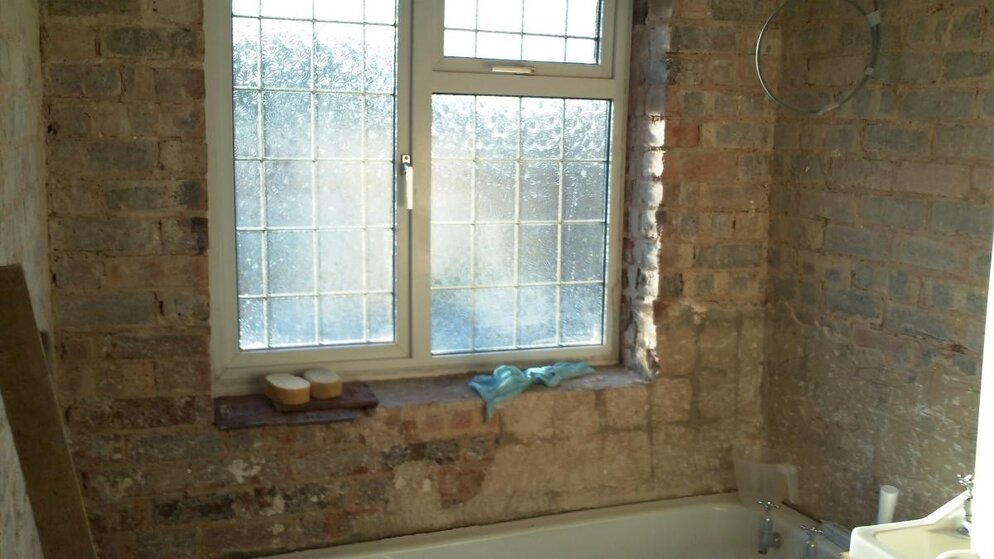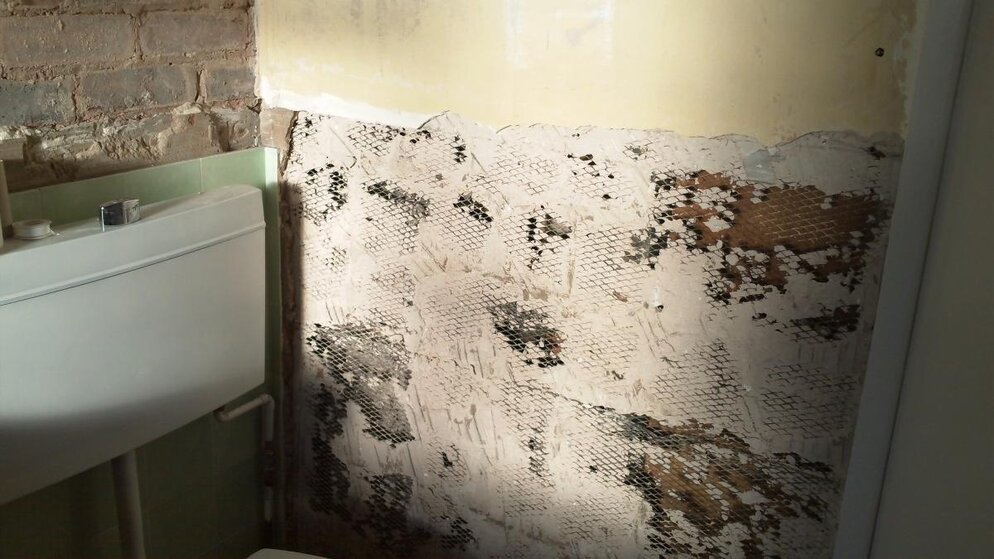D
dan9385
Hi guys,
I stumbled across this site at the weekend when searching online for some DIY bathroom advice. I've searched the forum but I can't find another post which answers my particular question so I thought I'd join and post it.
I've recently moved into a 1946 built house and I'm in the process of doing the bathroom. I could do with some advice as to what to use as tile backing around the bath/shower area. The bathroom was half tiled (lower) and half wallpapered (upper). I currently do not have a shower. I have removed most of the tiles apart from round the sink and toilet, and I've also removed the plaster from the walls as it was old and was no longer attached. See pic below.

The bath and shower (electric mounted over the bath) are going to be in a corner of 2 external walls, not stud walls. The shower will be mounted on the wall to the right of the window and I plan to tile each end of the bath, the wall with the window in it, and behind the sink. I'd like to use large-ish tiles in a brickwork style as I like the effect.
There is what looks like a layer of concrete behind the tiles and this has come away in part when I have removed the tiles. The old tiles were buttered on to the wall without about a half inch thick layer of something. It certainly didn't look like tile adhesive!
I have a friend of the family who is a plasterer who is going to be plastering the bathroom for me. He has advised me to buy 1200mm x 900mm x 12.5mm plasterboard, plasterboard adhesive, thistle bonding, and thistle multifinish from Wickes to re-plaster the bathroom. I think the plan is to plasterboard the lot, bond it then skim it. Although I could be wrong.
I've read horror stories which suggest that you shouldn't use plasterboard in a bath/shower area as the grout between the tiles will eventually become porus, water will get behind the tiles, the tiles will fall off, the plasterboard will rot etc etc. Others I've found say that it is OK to use plasterboard and that you can tile directly onto the plasterboard providing you use a primer. Others say you can use plasterboard but tank it first. Others say to use aquapanels. In reading the instructions for aquapanels on Wickes' website, it only talks about screwing them to stud walls and specifically says they are not suitable for direct bonding. I'm not sure exactly what that means?
I'm really confused as to what the best backing for the tiled area. Obviously I don't want to have to re-do everything in 6-12 months time because it has all fallen off or gone rotten, and I would much rather get it right from the start.
Also, on the other side of the bathroom I have a stud wall. In removing the tiles from this there is a mesh fixed to it which has been plastered. Would you recommend leaving that as it is and plastering over it or ripping it off and plasterboarding the stud wall? The old plaster at the top seems fairly well stuck to it and could probably just be skimmed. Again, there is a pic below to show what I mean.

If anyone here is willing to help me and give me a pointer in the right direction I would be extremely grateful!
Thanks in advance,
Dan
I stumbled across this site at the weekend when searching online for some DIY bathroom advice. I've searched the forum but I can't find another post which answers my particular question so I thought I'd join and post it.
I've recently moved into a 1946 built house and I'm in the process of doing the bathroom. I could do with some advice as to what to use as tile backing around the bath/shower area. The bathroom was half tiled (lower) and half wallpapered (upper). I currently do not have a shower. I have removed most of the tiles apart from round the sink and toilet, and I've also removed the plaster from the walls as it was old and was no longer attached. See pic below.

The bath and shower (electric mounted over the bath) are going to be in a corner of 2 external walls, not stud walls. The shower will be mounted on the wall to the right of the window and I plan to tile each end of the bath, the wall with the window in it, and behind the sink. I'd like to use large-ish tiles in a brickwork style as I like the effect.
There is what looks like a layer of concrete behind the tiles and this has come away in part when I have removed the tiles. The old tiles were buttered on to the wall without about a half inch thick layer of something. It certainly didn't look like tile adhesive!
I have a friend of the family who is a plasterer who is going to be plastering the bathroom for me. He has advised me to buy 1200mm x 900mm x 12.5mm plasterboard, plasterboard adhesive, thistle bonding, and thistle multifinish from Wickes to re-plaster the bathroom. I think the plan is to plasterboard the lot, bond it then skim it. Although I could be wrong.
I've read horror stories which suggest that you shouldn't use plasterboard in a bath/shower area as the grout between the tiles will eventually become porus, water will get behind the tiles, the tiles will fall off, the plasterboard will rot etc etc. Others I've found say that it is OK to use plasterboard and that you can tile directly onto the plasterboard providing you use a primer. Others say you can use plasterboard but tank it first. Others say to use aquapanels. In reading the instructions for aquapanels on Wickes' website, it only talks about screwing them to stud walls and specifically says they are not suitable for direct bonding. I'm not sure exactly what that means?
I'm really confused as to what the best backing for the tiled area. Obviously I don't want to have to re-do everything in 6-12 months time because it has all fallen off or gone rotten, and I would much rather get it right from the start.
Also, on the other side of the bathroom I have a stud wall. In removing the tiles from this there is a mesh fixed to it which has been plastered. Would you recommend leaving that as it is and plastering over it or ripping it off and plasterboarding the stud wall? The old plaster at the top seems fairly well stuck to it and could probably just be skimmed. Again, there is a pic below to show what I mean.

If anyone here is willing to help me and give me a pointer in the right direction I would be extremely grateful!
Thanks in advance,
Dan
